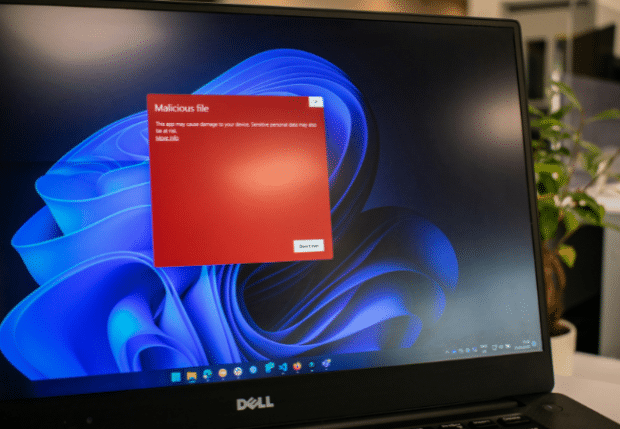Know the cyber threats Philippines will face in 2025
Philippine digitalization has been steadily progressing, but it will face powerful cyber threats as 2025 begins.
In its report, Check Point External Risk Management (formerly Cyberint) detailed these risks in “The Philippine Threat Landscape 2024-2025.”
READ: Shopping scam rate in PH is 36%, highest in 11 Asian countries
Take a closer look at the challenges the Pearl of the Orient must surmount to shine in the age of AI.
1. Malware

Malware is the most prevalent cyber threat in the country.
Check Point explains malware infections usually originate from personal devices.
Its business client’s employees typically use these devices for work-related activities, exposing corporate systems to more digital attackers.
The multinational software provider specified InfoStealers as one of the most destructive among malware types.
It has become a gateway for unauthorized access to vulnerable portals, facilitating data breaches.
Also, during the COVID-19 pandemic, companies adopted work-from-home arrangements.
This move helped personnel avoid the coronavirus but opened their businesses to Infostealer infections.
2. Social engineering

Check Point lists social engineering as one of the top cyber threats in the Philippines due to its effectiveness.
Cybersecurity firm Kaspersky defines it as “a manipulation technique that exploits human error to gain private information, access or valuables.”
Nowadays, there are many types of social engineering attacks, but they typically follow this cycle:
- Prepare by collecting information on a target individual or group.
- Infiltrate by establishing a relationship or interaction to build trust.
- Exploit the victim once the scammer establishes trust and weakness to advance their attack.
- Disengage once the scammer has completed their scheme.
Social engineering works because it takes advantage of human emotions and behaviors.
Consequently, its cyber threats often have the following forms:
- Posing as a trusted brand, government agency or authority figure via phishing
- Inducing fear or a sense of urgency by telling victims they only have a few moments to grab an opportunity
- Appealing to greed by promising massive amounts of wealth
- Appealing to one’s helpfulness or curiosity by tricking generous individuals into clicking spoof links to send aid
Nowadays, artificial intelligence has made these cyber threats more effective.
Learn more about their latest iterations in this Inquirer Tech guide.
3. Phishing and smishing

Cybersecurity firm Cloudflare says phishing involves masquerading as a reputable source to steal sensitive information and funds.
Smishing is a form of phishing that involves SMS or “texting.”
Check Point acknowledges the National Bureau of Investigation’s efforts in apprehending smishing scammers.
READ: CICC partners with DLS-CSB to create an anti-smishing tool
The National Bureau of Investigation and Filipinos in general must remain vigilant due to these emerging tactics:
- Device and geo-filtering: Recent phishing campaigns use these tactics to ensure they’re only accessible through Philippine IP addresses via mobile devices. Consequently, cybercriminals evade traditional security measures.
- Smishing via IMSI-Catcher Devices: IMSI-Catcher devices, a.k.a. cell-site simulators or “stingrays,” intercept mobile phone traffic. A recent phishing scheme took advantage of the All Saints’ and Souls’ Day holidays with these gadgets.
4. Social media impersonation

Cybercriminals create fake social media profiles to trick victims with fake promotions and services.
The Philippines faces more such cyber threats as scammers shun traditional methods for more advanced ones.
Specifically, they can use AI to impersonate celebrities accurately.
For example, they can use an AI chatbot to mimic a singer’s writing style and use another to generate fake images.
Fortunately, the latest AI scams have flaws you can detect to avoid them immediately.
Learn more about these techniques here.
5. Supply chain attacks

Cybersecurity company CrowdStrike says supply chain attacks “target a trusted third-party vendor who offers services or software vital to the supply chain.”
They can inject malicious code into an application or compromise physical components to infect all users.
Also, supply chain attacks can be stepping stones to accessing larger trading partners.
For example, hackers accessed the US supermarket chain Target’s HVAC contractor to enter its systems.
Cyberint Supply Chain Intelligence identified eight third-party vendor breaches that affected Filipino clients in 2024.
Most of these attacks targeted the Finance and Energy sectors, causing data leaks from unsecured systems and credential exposures.
6. Ransomware

Ransomware locks a computer’s files until a victim pays a huge sum to a hacker.
The Check Point report says the Philippines experienced fewer ransomware attacks in 2024 compared to 2023.
It attributes the decline to limited resources for local threat actors who rely on open-source tools.
Moreover, ransomware campaigns prefer larger countries and organizations for higher payouts and prestige.
Nevertheless, the Philippines must bolster its defenses against cyber threats as it ramps up digitalization.
The Philippine cybersecurity landscape

“The Philippine Threat Landscape 2024-2025” report breaks down the Filipino cyber attacks in 2024 via sector:
- Banking and financial services: 66%
- Media and entertainment: 11%
- Technology and IT: 8%
- Real estate: 6%
- Retail and consumer goods: 5%
- Healthcare: 2%
- Energy and Industrial: 1%
- Hospitality: 0.6%
- Shared services: 0.4%
Hackers and scammers purchase malicious tools and services from underground marketplaces.
In 2024, Cyberint recorded a 100% increase in underground marketplace activity on Telegram related to the Philippines.
They have been purchasing the following illicit items to execute cyber threats in the country:
- “FULLZ” or “Full Information” from phishing and other scams that support more malicious campaigns.
- Exploit Tools and Attackware like webshells, RDP and SSH tools for exploiting vulnerabilities
- Malware and Malware-as-a-Service, which typically have lower costs for aspiring cyber criminals.
- Email and SMS tools like bulk SMS services, email blasting tools and cPanel access bundled with phone numbers OTPs and e-SIMS
- Fake Documents for social engineering attacks, such as fake bank statements, invoices and IDs
- Money Laundering Services that facilitate hiding and transferring illicit funds via mule accounts, remittance accounts or digital wallets
In 2025, the Philippines will face more advanced versions of the cyber threats above. These include more sophisticated supply chain attacks and social engineering techniques.
Moreover, geopolitical tensions with China will likely increase state-sponsored attacks on the country.
These powerful cyberattacks started early this year as the Office of the President experienced a digital breach.
READ: How the Philippines defends against cyberattacks
The Philippines needs the latest tools to secure its digital future.
Protect yourself, your family and your company from cyberattacks by learning the best practices at Inquirer Tech.